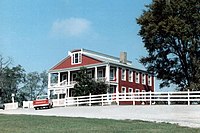|
Junction, Illinois
Junction is a village in Gallatin County, Illinois, United States. The population was 56 at the 2020 census.[3] History Junction was founded in the 1880s, and was named for its location at the junction of the L&N and B&O railroads. When a post office was established in 1884, it was named "Cypress Junction." The name was changed to "Junction City" in 1888, and shortened to "Junction" in 1894.[4] Junction's location in a relatively flat area leaves it prone to flooding along the Ohio River, which can cause waters in the nearby Saline River to back up. A major flood in March 1997 displaced several area residents and blocked all but one road leading into the village.[5] On June 1, 2022, Junction General Baptist Church burned down after lightning struck the steeple.[6] Crenshaw HouseThe Hickory Hill mansion, almost five miles west of Junction, is the 19th-century home of illegal slave trader and slave breeder John Hart Crenshaw. It was infamously known as the "Old Slave House," as it was used as a criminal front for the kidnapping of free blacks who were illegally sold into the Southern slave trade on the Reverse Underground Railroad, as well as a farm for slave breeding.[7] GeographyJunction is located at the center of Gallatin County at 37°43′22″N 88°14′17″W / 37.72278°N 88.23806°W (37.722726, -88.237973).[8] The village lies along Illinois Route 13, a few miles west of the Ohio River, and north of the Shawnee National Forest. The Saline River, a tributary of the Ohio, passes just to the south. According to the 2010 census, Junction has a total area of 0.883 square miles (2.29 km2), of which 0.88 square miles (2.28 km2) (or 99.66%) is land and 0.003 square miles (0.01 km2) (or 0.34%) is water.[9] Demographics
As of the 2020 census, there were 56 people, 35 households, and 38 families residing in the village. The racial makeup of the village was 92.9% White. Hispanic or Latino of any race were 1.79% of the population.[11] There were 35 households, out of which 10.2% had children under the age of 18 living with them, 68.6% were married couples living together, 22.9% had a female householder with no husband present. The median income for a household in the village was $32,375, and the median income for a family was $42,500. 45.5% of those over 64 were living below the poverty line. Notable people
Further reading
References
External linksWikimedia Commons has media related to Junction, Illinois. |
||||||||||||||||||||||||||||||||||||||||||||||||||||||||||||||||||||||||||||||||||||||||||||||||||||||



